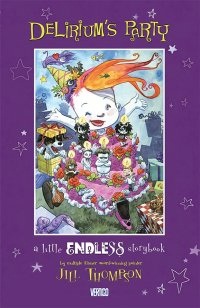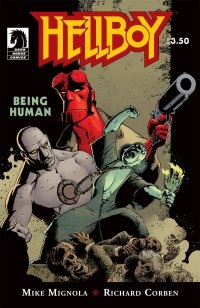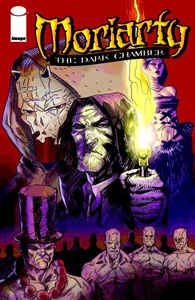 Delirium’s Party: A Little Endless Storybook (Vertigo, $14.99)
Delirium’s Party: A Little Endless Storybook (Vertigo, $14.99)
By Adam Prosser
One of the greatest things about Neil Gaiman’s Sandman was the fact that, as a story about stories, it could spin out in dozens of fascinating directions that had only a tenuous connection to the main storyline. In fact, I maintain to this day that Sandman is probably the best single use of the “modular” storytelling format that comics began to adopt in the Bronze Age, in which an array of wildly different smaller stories fit together to tell a single, epic tale. It’s no coincidence that many of the characters and ideas Gaiman introduced took on a life of their own outside the core comic, from the big breakout star—his cute goth version of Death—to his Miltonian Lucifer, to the larger cast of the Dreaming…and that’s not counting the characters like Cain and Abel who had already appeared in their own books before Sandman came along.
The concept of the “Lil’ Endless”, basically a “Muppet Babies” take on the Sandman mythos, popped up in the original series story “A Parliament of Rooks” (which was itself comprised of a series of different stories), it seemed more like a tongue-in-cheek gag than anything; they were created by the well-meaning, neurotic Abel as a cutesy version of the “real” story that could be told to the visiting baby Daniel, all while his more violent brother Cain bemoaned this bowdlerization of the darker, more cosmic story. Cain all but turned to the reader and whined, “That Gaiman! What a sellout!” It was a clever way to pre-emptively answer fan complaints, and nudge the sometimes overly-serious and gothy fanbase to lighten up (a surprisingly consistent message throughout the series, by the way, for all that it’s usually regarded as humourless and self-important by people who haven’t read it.) Still, it’s unlikely Gaiman meant for the Lil’ Endless to be more than a one-off joke…yet, they’ve lingered in the imagination of Jill Thompson, the artist who drew the Lil’ Endless in the first place, and who has handled a number of Sandman spinoffs, including the Death manga and The Dead Boy Detectives. She’s since produced The Lil’ Endless Storybook (just re-released) and now the sequel, Delirium’s Party.
This being a kid’s book, the story is pretty simple. Delirium, the youngest of the Endless, who even in the main series basically acts like a little kid despite being billions of years old, comes to the realization that she’s never seen her sister Despair smile. She throws a surprise party and convinces all the other Endless to give her gifts, but of course cheering up Despair is a challenging proposition.
This book is basically the epitome of a kid’s book that the adults reading it will also get a kick out of; obviously, a sense of childlike wonder was a big part of what made Sandman successful in the first place, and for fans, any expansion on the mythos is welcome. Thompson also manages to sneak in a bit of the darkness and almost Lovecraftian existentialism that pervades the original series—no matter how cutesily they’re drawn, after all, we’re still dealing with the embodiments of Death, Destruction, and so on. So start indoctrinating your kids into the mind-shredding cosmic truths lurking beyond mortal existence early with a delightful picture book! And anyone who might actually be uptight enough to think that something like this waters down the original Sandman mythos, the message is pretty obvious: lighten up.
Rating: 




Out of a Possible 5 Stars
 Hellboy: Being Human (Dark Horse, $3.50)
Hellboy: Being Human (Dark Horse, $3.50)
By Jeb D.
Given that Hellboy began not as a concept, but as a design (a sketch that Mike Mignola did at a Con years ago), it’s interesting that it’s the graphic elements of the character that Mignola has ceded to his collaborators; he continues to write the stories, while enlisting artists of the first rank to supply the art. It seems like just the other day that we had the Hellboy: Buster Oakley Gets His Wish one-shot, with Kevin Nowlan synching his wonderfully Creepy/Eerie/Eric Powell-like art with Mignola’s retro-50’s style comic horror yarn. For this book, Mignola has returned to something closer to the sense of dread that characterized the earliest Hellboy stories–a propos, as he’s brought back Roger the Homunculus, first introduced in the “Wake the Devil” storyline–and is once more teamed with horror vet Richard Corben, producing a comic that is as visually dark and evocative as any Hellboy installment ever: foul evil dwells in a southern gothic-style mansion, populated by monsters and ghosts (both literal and metaphoric), the dead and near-dead, and the sense of rot and ruin is palpable.
All well and good, and fans of Corben need read no further-you’ll love it. But what of those wondering if it’s already time to pony up another $3.50 for a self-contained, out-of-continuity “prequel” Hellboy story. Well, that’s a little trickier…
As usual, Mignola’s got a nice sense for fitting his story to the demands of the single issue format. And, as with Buster Oakley, he’s come up with an effective cast of supporting characters and a dark tale (with a predictable conclusion) for them to tell. It’s very much Roger’s story, and if it never deviates from its obvious path, he does get some nice moments (including a cringingly violent fight sequence).
Hellboy? Um… he’s here, but as I say, it’s hardly his story at all. Mignola quickly pushes him out into the field with Roger more or less on a whim, they confront evil, Hellboy tosses out some bad-tempered snarls, and wraps things up with some platitudes to Roger about what it means to be (in)human. In other words, it’s basically the same Hellboy story that Mignola has written for about three-quarters of the character’s existence: evil happens, Red shows up, throws a few punches and insults, and we all go home. If this were my first exposure to the character, I’d probably be intrigued. But, like most of you, it’s not my first… it’s about my dozenth, and I’m really feeling a sense of diminishing returns. Rich Corben is godlike, don’t get me wrong, he’s the reason for the recommendation… but it feels to me as though it’s time for Mignola to switch places and focus on the visuals of this series, and let someone else spin the yarns.
Rating: 




Out of a Possible 5 Stars
 Moriarty: The Dark Chamber #1 (Image, $2.99)
Moriarty: The Dark Chamber #1 (Image, $2.99)By Jeb D.
It’s kind of a truism that in fiction, it’s easy to fall in love with the bad guys in a way we don’t with heroes; villains usually represent a freedom of some sort, a disregard of rules and convention, that we’d love to be able to experience ourselves without consequence.
As a result. villainous characters are almost irresistibly tempting for writers to shape into protagonists, a prospect that’s fraught with peril: how interesting is a villain who’s restricted from playing the role of antagonist, and bound by principle? It’s not impossible to get it right-Mark Waid and Barry Kitson’s Empire was a fine imagining of the challenges faced by a Dr. Doom-like supervillain at his presumed moment of triumph-but too often, we find the former “bad guy” removed from the environment that birthed his enmity (typically, the “hero” that once opposed him is out of the picture one way or another), and he’s left to face the challenge of a force of evil that counterbalances even his own, saddling him, by default, with the limitations of the “hero,” and concomitant loss of much of his appeal.
And in large part, that’s what we have in the first issue of Moriarty: The Dark Chamber. It’s the early 20th century, we’re in LEOG territory once again, and Sherlock Holmes has finally passed away for good. His great “nemesis,” James Moriarty, is trying to maintain a low-profile identity in London as a businessman and “investigator” for other criminals (he employs but a single henchman), when, amid the gathering storm of the Great War, he is made aware of threats from the Black Hand criminal organization, and a mysterious disappearance . And for Moriarty, bored with the pettiness of London crime, the game is, naturally, afoot.
And here’s the crux of the story: what we (or at least I) really would like to see is Moriarty meeting this problem with some sort of unique, dark “mathematical” genius (which, of course, writer Daniel Corey would have to invent, since Doyle never got round to it). Unfortunately, the story takes the more obvious approach of assuming that Holmes and Moriarty were not simply opponents, but mirror images, and the good professor brings all of Holmes’ usual observational and deductive resources to bear: reading a note with a magnifying glass, he tells us: “This paper… reminds me of the sort I frequently used during my time in India… there is indentation in the grain at the end of each stroke where the ink failed to release… the fine fibers have broken neatly under the pen’s nib, indicating a new writing instrument…” then going on from there to deduce the writer’s age, profession, educational background, etc. You get the picture: it’s Holmes to a “T.” Instead of being shown how an “evil genius” might meet the challenge of a monstrous criminal organization, and the onset of war, we get to see Moriarty become his own version of his old foe. And it’s not as though we see him experimenting with the great detective’s methods, and coming to the realization that this is something he can use (which might make an interesting journey of discovery): it’s clear that these powers are already fully developed in Moriarty. So (at least as of this issue), Moriarty becomes just another in the long line of Holmes successors, rather than something new.
It’s interesting that (following the recent Strange Case of Mr. Hyde), we have yet another Victorian (well, technically Edwardian)-era comic brought to us by a pair of relative newcomers. So far, I have to give the edge to Moriarty: Corey is more idiomatic, and has a better sense of the period (just for starters, Moriarty doesn’t call anyone “uptight”). Artist Anthony Diecidue eschews the Kevin O’Neill impersonation we saw in M.S. Corley’s Hyde for something rougher and darker (I’m put in mind of Guy Davis crossed with Ben Templesmith), which certainly suits the period and what we expect of the character.
Moriarty: The Dark Chamber is off to a good start, if you’re in the mood for a dark post-Victorian mystery thriller, with a protagonist modeled on Sherlock Holmes. But it remains for someone else to show us just what Moriarty’s unique genius might have been, and what it could do, rather than seeing him shaped into the image of his old adversary.
Rating: 




Out of a Possible 5 Stars